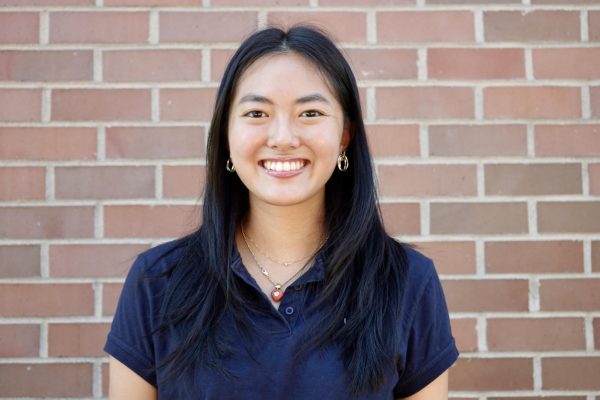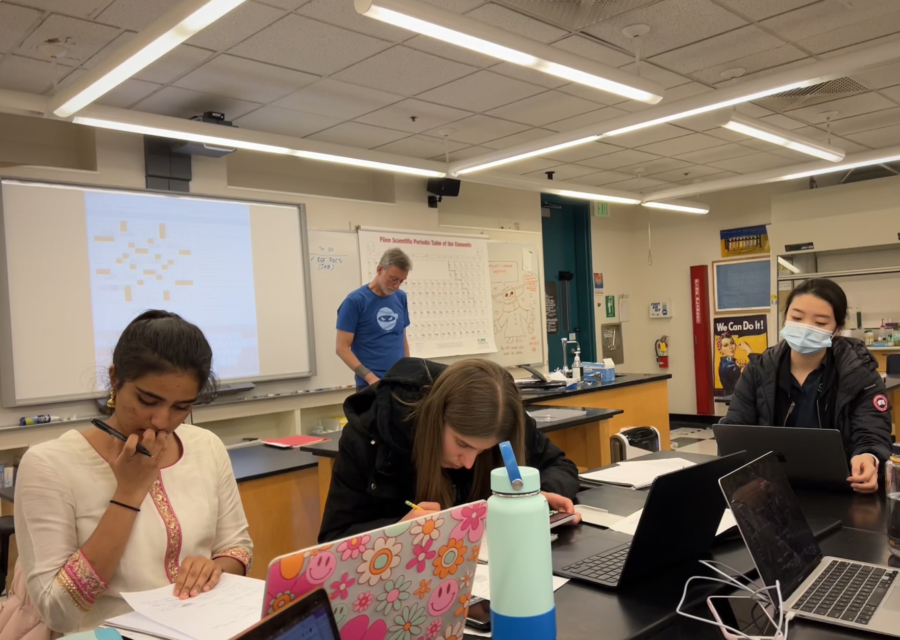Castilleja: A Cult of Crossword Enthusiasts
Students work on Chemistry problems as Colin Quinton solves a NYT crossword
6.02 * 10^23 (Avogadro’s number) Down: Culprit responsible for starting the crossword craze? Colin Quinton.
Quinton, a chemistry teacher here at Castilleja, is known by the class of 2025 for spreading his crossword obsession to the student body. If you’ve ever sat in Quinton’s class, you may notice that a crossword puzzle is occasionally projected on the screen.
Mika Cham ’25 specifically recalled her crossword infection beginning after a period 6 Chemistry exam when Quinton broadcast his crossword puzzle to the class. Cham remembers students gathering in the front of the classroom, herself included, and voicing answers to some of the hints: “Oh! 22 Across is ____.”
During the next class, Quinton introduced a new phenomenon to the now-crossword-intrigued period: the “Mini.” A tiny crossword curated by The New York Times as an alternative to the original, lengthy puzzle, the “Mini” was a hit amongst the students. With fewer cells and hints than the average crossword, the Mini was a new challenge as many students attempted this puzzle and were able to hit around the two-and-a-half minute mark.
Cham recollected Quinton being playfully disappointed in the class, who believed that his students could solve it faster. Knowing she had to redeem herself, she stated, “I wanted to prove myself.” Thus, her journey, as well as many other sophomores’ crossword adventures, began.
Crossword solving was also a hit amongst teachers and students of other grades. Just to name a few, Dr. Landes, Mr. Rockman, and Ms. Appleberry are all avid crossword solvers. It seems Quinton has also affected the Castilleja teacher population with Dr. Landes noting, “I got into crosswords due to Quinton and COVID.”
Ms. Appleberry, referred to as a “crossword legend” from Mr. Quinton, has also spread the crossword love: Joanne Zhao ’24 says that Ms. Appleberry offered her a stack of crossword puzzles, helping Joanne jumpstart her crossword career.
At this point, it is clear crossword puzzles have some sort of addictive quality if students and teachers are all racing to solve them. But what makes crossword puzzles so compelling? Crossword puzzles may appear intimidating or challenging at first. As Quinton put it, “[They] felt like an intellectual barrier.” However, after consistently solving crosswords over the years, Quinton now sees them with a “sense of enjoyment.”
He also notes that crossword puzzles are less about intelligence and rather more about perseverance and logic. Crossword puzzles are low stakes, entertaining experiences through which connecting and collaborating with others is encouraged. For example, Quinton regularly bonds with Ms. Appleberry with casual conversations about certain crossword clues.
Another surprising reward of solving a NYT crossword is the “little jazzy tune,” as Cham describes it, that plays once you have all the correct solutions. Cham backs up its catchiness: “[It] really reels you in.” If you’d like to sample this song, it’s just a NYT-crossword-puzzle away.
If you feel compelled to crossword, here are some helpful tips from Castilleja’s crossword enthusiasts.
Don’t aim for perfection, and practice!
Quinton notes that some people have this idea of a “pure solve,” but he claims that searching answers up isn’t wrong or cheating. Rather, getting the answer to a hard crossword hint could help you bridge the gap from frustrated beginner to confident enthusiast; plus, it’ll help you fill in other spaces as well. Dr. Landes also adds that crossword puzzles have a “flavor” to them. As crossword solving becomes routine, understanding is created; there are certain hints that make sense, and it’s easier to know what to expect. Don’t get too intimidated at first as everything will slowly ease its way into place.
Day-of-the-week indicates difficulty level
Another thing to note with many crossword puzzles is that they have a range of difficulties depending on what day it is. For example, for the NYT, the difficulty levels increase as the week goes on: Mondays are the easiest, while Saturdays may lead to many blank cells, and Sundays are the biggest. On the other hand, The New Yorker’s crosswords decrease in difficulty from Monday-Thursday, and Friday puzzles have a theme. Both Quinton and Cham suggest beginners to start out with NYT Monday puzzles and work your way up.
Work with others
Quinton and Cham both agree that crossword solving would not be as fulfilling or fun without collaborators. Quinton states, “Crossword solving is not a solo challenge: it’s a game.” Solving crosswords with friends can be a great way to build better bonds and encourage camaraderie.
If all of this has inspired you to open up the NYT and solve a crossword puzzle, you should definitely try it out. It’s an intellectual and rewarding challenge for all age groups, filled with fun puns and themes that will require you to think outside the cells. Quinton, Cham, and I have started a crossword club (named CXWC23), and we encourage anyone interested to check it out and solve some puzzles with us. As Quinton promotes, “Crossword puzzles are a good way to pass the time while keeping one’s mind active.”

Priscilla Chan '25 is an Editor-in-Chief for Counterpoint. She hopes to improve her interview skills and is excited to publish more articles this year....


